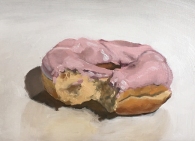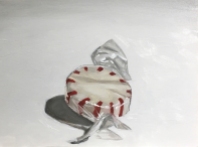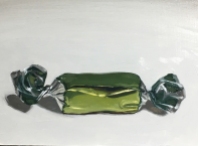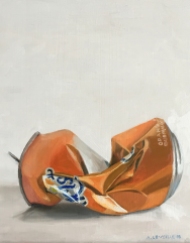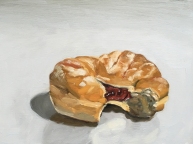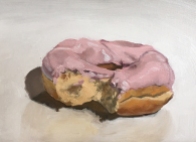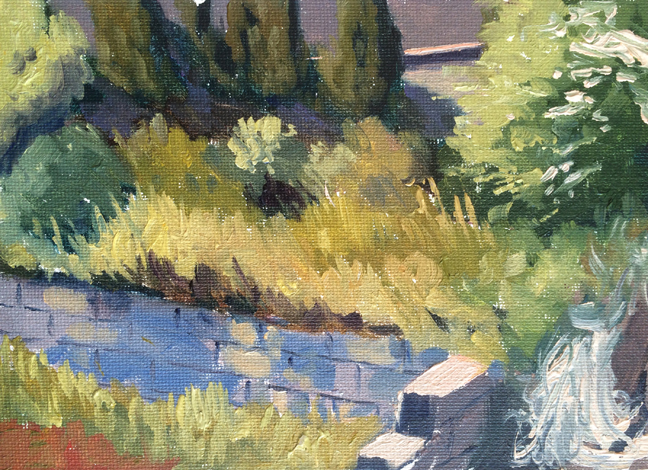One of my interests outside of art-making is modern design. I’ve studied and collected modernism for a number of years. This February I was honored and excited to have my essay chosen by the Eames Office and the Barbican Centre as the winning entry in their “Your Eames Story” contest.
The essay below describes my introduction to, and subsequent obsession with, modern design through the work of Charles and Ray Eames.
FROM THERE TO HERE
Sometime in the mid 1980s, my father was perusing the offerings of the swap-shack, a common feature at rural garbage dumps in which folks leave usable goods for others to take. Our family was pragmatic and not wealthy, and we had acquired any number of practical items from the swap-shack: Ice skates for me and my siblings, blenders, picture frames, farm equipment, etc. On this day, my father brought home two treasures. One was a life sized Halloween decoration—a ceramic bust of a witch, complete with a built in light bulb to illuminate her clear glass eyes.  The other my father later described as “the ugliest chair (he) had ever seen.” Naturally, he had to have it.
The other my father later described as “the ugliest chair (he) had ever seen.” Naturally, he had to have it.
Both items ended up unceremoniously tossed into the upper hayloft of our barn, a catchall place that was the backdrop to my childhood adventures. Through the years, the black plywood chair sat quietly in the background, tucked between the wall and a dusty stack of old window screens. The witch’s head received far more attention and play, eventually suffering a spectacular fall (or was she pushed?) that shattered her into a million pieces.
In the early 2000s, I returned home from college to store some belongings in the barn. As I tucked my mountain bike against the wall of the loft, I moved aside the black plywood chair and was struck by its form. What was it that I was seeing? It was a shape that was almost familiar, but that I couldn’t quite place.
When I returned to Boston, I typed “plywood chair” into a search engine, and there was the very same piece from my father’s barn. Or was it? There seemed to be two models of this particular chair: A lounge chair and a dining chair. I was uncertain which one I had encountered, so I began reading. Through various websites, blogs, and forums, I discovered the chair in my father’s barn was an Eames DCW (Dining Chair Wood). It was a design icon. And just like my father, I had to have it.
The next time I spoke to my father was Thanksgiving, and when he asked what I wanted for Christmas I mentioned, as casually as I could, the chair in the loft.
Christmas arrived. There was no chair. My father seemed surprised when I asked about it. “Oh that?” he said, “You can just take that… I didn’t think you were serious.”
I hesitate to use the word fate, although I can’t think of another way an Eames chair would end up at a garbage dump in a rural New Hampshire. My town, with a population of less than 5,000, was not exactly a hotbed of modernism. But the chair was there, and though dented, chipped, and paint splattered, having clearly lived a long life, it sparked a design obsession.
I devoured everything I could about the Eameses, and through them was introduced to the other great designers of modernism. Countless hours were spent combing Craigslist and eBay for vintage pieces. I went on shopping sprees, voraciously collecting dozens and dozens of chairs—not just to own and use, but from which to learn. I observed and catalogued the minutia of glides, shock-mounts, chair bases, and wood varieties; each new chair brought fresh insights and understanding of the design process and how profoundly small changes affected the interaction of the user and the object.
Seeing and touching the pieces taught me things I could never have learned otherwise. My collecting also earned me some strained relationships. Late one Saturday night, I pleaded with a friend to borrow his car—and his ATM card—to pick up a set of vintage plywood chairs. Thankfully, he obliged. A pair of roommates were less understanding, and they politely asked me to move out after I had acquired upwards of 50 chairs in the course of two years.
But, eventually, my obsession became a focus, and then a career. In 2006, I began working at that glittering temple of modernism: Design Within Reach. I slowly whittled down my collection of chairs to those I used every day. I expanded my knowledge about other designers of the modernist movement. My enthusiasm was channeled into teaching clients about the nature and flexibility of modernism. The recession of 2008 sharply brought into focus the need for practical, timeless designs, and naturally the work of Charles and Ray Eames rose to the forefront.
My obsession also moved beyond furniture and became a way of living. I learned from the Eameses that the world is never perfect, but is always improvable. They taught me that work should be playful and that play should be taken seriously, no matter the application. Their process contains a brightness and optimism that can just as easily be applied to social justice or environmental sustainability as it can be to chairs and tables. It is seeing hope emerge through the clouds of fear and war, as relevant now as in the 1950s.
I still work for Design Within Reach, having managed the Cambridge studio since 2009. My enthusiasm for modernism has not waned. Each day I work among some of the most beautiful designs in history. I get to share my passion and enthusiasm with my coworkers, and help educate my clients. For the Eameses and their little plywood chair—and for my father—I am ever grateful.
Adam Leveille
You can visit the Eames Office here:
http://www.eamesoffice.com/your-eames-story/from-there-to-here/
and the Barbican Centre Blog here:
http://blog.barbican.org.uk/2016/02/your-eames-story/













































